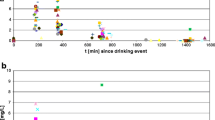Abstract
The direct ethanol metabolites, ethyl glucuronide (EtG) and ethyl sulfate (EtS), are of increasing importance for clinical and forensic applications, but there are only few studies on the kinetics of EtG in serum and none on EtS. In this study, 13 volunteers (social drinkers) drank ethanol in the form of white wine to reach a blood alcohol concentration of 0.51 ± 0.17 g/kg, and blood and urine samples were analyzed for EtG and EtS simultaneously by chromatography-tandem mass spectrometry (LC-MS/MS). Mean peak serum EtG and EtS concentrations were 2.9 ± 1.3 and 2.8 ± 1.6 μmol/l, respectively, and were reached between 4.0 ± 0.9 h after the start of drinking (3.0 ± 0.5 h for EtS). The mean time differences between reaching maximum blood ethanol levels and serum metabolite levels were 2.3 ± 0.9 h for EtG and 1.2 ± 0.5 h for EtS. In the last blood samples collected (10–11 h after the start of drinking), 11 (of 13) volunteers were still positive for EtG in serum, whereas only 2 were positive for EtS. In the serum of one female person, no EtS was detectable at any time; however, it was excreted in the urine in (low) concentrations. Ethanol was detectable in the serum for up to 8.6 h after the start of drinking, whereas EtG and EtS were detectable up to more than 5.8 h (EtG) and 4.0 h (EtS), respectively. Mean peak urinary concentrations were 401 ± 232 μmol/l for EtG and 266 ± 153 μmol/l for EtS, and mean peak levels were reached 6.2 ± 0.9 h (EtG) and 5.3 ± 1.2 h (EtS) after the start of drinking. Maximum concentrations of EtG and EtS in serum showed a wide interindividual variation and could not be correlated to the maximum blood ethanol concentrations. Correlations (p < 0.001, Kendall’s Tau b) were found when comparing pairs of parameters, but mostly involved areas under the curve (AUC) of metabolites or of ethanol; one correlation linked the peak concentrations of EtG and EtS in urine.



Similar content being viewed by others
References
Barbour AD (2001) Simplified estimation of Widmark “r” values by the method of Forrest. Sci Justice 41:53–54
UGT Alleles Nomenclature Home Page. UGT Nomenclature Committee. June 2005. [21.03.2007]. http://galien.pha.ulaval.ca/alleles/alleles.html
Dresen S, Weinmann W, Wurst FM (2004) Forensic confirmatory analysis of ethyl sulfate—a new marker for alcohol consumption—by liquid-chromatography/electrospray ionization/tandem mass spectrometry. J Am Soc Mass Spectrom 15:1644–1648
Droenner P, Schmitt G, Aderjan R, Zimmer H (2002) A kinetic model describing the pharmacokinetics of ethyl glucuronide in humans. Forensic Sci Int 126:24–29
Foti RS, Fisher MB (2005) Assessment of UDP-glucuronosyltransferase catalyzed formation of ethyl glucuronide in human liver microsomes and recombinant UGTs. Forensic Sci Int 153:109–116
Helander A, Beck O (2004) Mass spectrometric identification of ethyl sulfate as an ethanol metabolite in humans. Clin Chem 50:936–937
Helander A, Dahl H (2005) Urinary tract infection: a risk factor for false-negative urinary ethyl glucuronide but not ethyl sulfate in the detection of recent alcohol consumption. Clin Chem 51:1728–1730
Kardon T, Coffey MJ, Banhegyi G, Conley AA, Burchell B, Mandl J, Braun L (2000) Transcriptional induction of bilirubin UDP-glucuronosyltransrase by ethanol in rat liver. Alcohol 21:251–257
Nash RM, Stein L, Penno MB, Passananti GT, Vesell ES (1984) Sources of interindividual variations in acetaminophen and antipyrine metabolism. Clin Pharmacol Ther 36:417–430
Politi L, Morini L, Groppi A, Poloni V, Pozzi F, Polettini A (2005) Direct determination of the ethanol metabolites ethyl glucuronide and ethyl sulfate in urine by liquid chromatography/electrospray tandem mass spectrometry. Rapid Comm Mass Spectrom 19:1321–1331
Schloegl H, Dresen S, Spaczynski K, Stoertzel M, Wurst FM, Weinmann W (2006) Stability of ethyl glucuronide in urine, post-mortem tissue and blood samples. Int J Legal Med 120:83–88
Schneider H, Glatt H (2004) Sulpho-conjugation of ethanol in humans in vivo and by individual sulphotransferase forms in vitro. Biochem J 383:543–549
Thomae BA, Rifki OF, Theobald MA, Eckloff BW, Wieben ED, Weinshilboum RM (2003) Human catecholamine sulfotransferase (SULT1A3) pharmacogenetics: functional genetic polymorphism. J Neurochem 87:809–819
Weinmann W, Schaefer P, Thierauf A, Schreiber A, Wurst FM (2004) Confirmatory analysis of ethylglucuronide in urine by liquid-chromatography/electrospray ionization/tandem mass spectrometry according to forensic guidelines. J Am Soc Mass Spectrom 15:188–193
Wurst FM, Metzger J (2002) The ethanol conjugate ethyl glucuronide is a useful marker of recent alcohol consumption. Alcohol Clin Exp Res 26:1114–1119
Wurst FM, Skipper GE, Weinmann W (2003) Ethyl glucuronide—the direct ethanol metabolite on the threshold from science to routine use. Addiction 98(Suppl 2):51–61
Wurst FM, Wiesbeck GA, Metzger JW, Weinmann W (2004) On sensitivity, specificity, and the influence of various parameters on ethyl glucuronide levels in urine—results from the WHO/ISBRA study. Alcohol Clin Exp Res 28:1220–1228
Wurst FM, Alling C, Aradottir S et al (2005) Emerging biomarkers: new directions and clinical applications. Alcohol Clin Exp Res 29:465–473
Acknowledgements
The authors wish to thank the “Bund gegen Alkohol und Drogen im Straßenverkehr e.V.” for the funding of the study.
Author information
Authors and Affiliations
Corresponding author
Electronic supplementary material
Below is the link to the electronic supplementary material.
Rights and permissions
About this article
Cite this article
Halter, C.C., Dresen, S., Auwaerter, V. et al. Kinetics in serum and urinary excretion of ethyl sulfate and ethyl glucuronide after medium dose ethanol intake. Int J Legal Med 122, 123–128 (2008). https://doi.org/10.1007/s00414-007-0180-8
Received:
Accepted:
Published:
Issue Date:
DOI: https://doi.org/10.1007/s00414-007-0180-8




